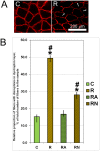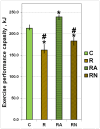L-arginine supplementation protects exercise performance and structural integrity of muscle fibers after a single bout of eccentric exercise in rats
- PMID: 24736629
- PMCID: PMC3988069
- DOI: 10.1371/journal.pone.0094448
L-arginine supplementation protects exercise performance and structural integrity of muscle fibers after a single bout of eccentric exercise in rats
Abstract
Eccentric exercise is known to disrupt sarcolemmal integrity and induce damage of skeletal muscle fibers. We hypothesized that L-arginine (L-Arg; nitric oxide synthase (NOS) substrate) supplementation prior to a single bout of eccentric exercise would diminish exercise-induced damage. In addition, we used N-nitro-L-arginine methyl ester hydrochloride (L-NAME; NOS inhibitor) to clarify the role of native NOS activity in the development of exercise-induced muscle damage. Rats were divided into four groups: non-treated control (C), downhill running with (RA) or without (R) L-Arg supplementation and downhill running with L-NAME supplementation (RN). Twenty four hours following eccentric exercise seven rats in each group were sacrificed and soleus muscles were dissected and frozen for further analysis. The remaining seven rats in each group were subjected to the exercise performance test. Our experiments showed that L-Arg supplementation prior to a single bout of eccentric exercise improved subsequent exercise performance capacity tests in RA rats when compared with R, RN and C rats by 37%, 27% and 13%, respectively. This outcome is mediated by L-Arg protection against post-exercise damage of sarcolemma (2.26- and 0.87-fold less than R and RN groups, respectively), reduced numbers of damaged muscle fibers indicated by the reduced loss of desmin content in the muscle (15% and 25% less than R and RN groups, respectively), and diminished µ-calpain mRNA up-regulation (42% and 30% less than R and RN groups, respectively). In conclusion, our study indicates that L-Arg supplementation prior to a single bout of eccentric exercise alleviates muscle fiber damage and preserves exercise performance capacity.
Conflict of interest statement
Figures





Similar articles
-
[Protective effect of nitric oxide on cytoskeletal proteins in skeletal muscles under eccentric exercise].Biofizika. 2009 May-Jun;54(3):515-21. Biofizika. 2009. PMID: 19569515 Russian.
-
Nitric oxide synthase inhibition attenuates the skeletal muscle VEGF mRNA response to exercise.J Appl Physiol (1985). 2000 Apr;88(4):1192-8. doi: 10.1152/jappl.2000.88.4.1192. J Appl Physiol (1985). 2000. PMID: 10749807
-
Role of nitric oxide in muscle regeneration following eccentric muscle contractions in rat skeletal muscle.J Physiol Sci. 2013 Jul;63(4):263-70. doi: 10.1007/s12576-013-0262-y. Epub 2013 Apr 21. J Physiol Sci. 2013. PMID: 23606218 Free PMC article.
-
Nitric oxide synthase inhibition during treadmill exercise reveals fiber-type specific vascular control in the rat hindlimb.Am J Physiol Regul Integr Comp Physiol. 2010 Feb;298(2):R478-85. doi: 10.1152/ajpregu.00631.2009. Epub 2009 Dec 9. Am J Physiol Regul Integr Comp Physiol. 2010. PMID: 20007515 Free PMC article.
-
Nitric oxide in skeletal muscle: inhibition of nitric oxide synthase inhibits walking speed in rats.Nitric Oxide. 2001 Jun;5(3):219-32. doi: 10.1006/niox.2001.0348. Nitric Oxide. 2001. PMID: 11384195
Cited by
-
Arginine promotes myogenic differentiation and myotube formation through the elevation of cytoplasmic calcium concentration.Anim Nutr. 2021 Dec;7(4):1115-1123. doi: 10.1016/j.aninu.2021.05.010. Epub 2021 Sep 28. Anim Nutr. 2021. PMID: 34738042 Free PMC article.
-
Effects of Beetroot Juice on Recovery of Muscle Function and Performance between Bouts of Repeated Sprint Exercise.Nutrients. 2016 Aug 18;8(8):506. doi: 10.3390/nu8080506. Nutrients. 2016. PMID: 27548212 Free PMC article. Clinical Trial.
-
Mechanisms of eccentric contraction-induced muscle damage and nutritional supplementations for mitigating it.J Muscle Res Cell Motil. 2022 Sep;43(3):147-156. doi: 10.1007/s10974-022-09625-1. Epub 2022 Jul 19. J Muscle Res Cell Motil. 2022. PMID: 35854160 Review.
-
NO-Dependent Mechanisms of Myosin Heavy Chain Transcription Regulation in Rat Soleus Muscle After 7-Days Hindlimb Unloading.Front Physiol. 2020 Jul 10;11:814. doi: 10.3389/fphys.2020.00814. eCollection 2020. Front Physiol. 2020. PMID: 32754051 Free PMC article.
-
Applications of Eccentric Exercise to Improve Muscle and Mobility Function in Older Adults.Ann Geriatr Med Res. 2022 Mar;26(1):4-15. doi: 10.4235/agmr.21.0138. Epub 2022 Jan 18. Ann Geriatr Med Res. 2022. PMID: 35038818 Free PMC article.
References
-
- Armstrong RB, Warren GL, Warren JA (1991) Mechanisms of exercise-induced muscle fibre injury. Sports Med 12: 184–207. - PubMed
-
- Knoblauch MA, O’Connor DP, Clarke MS (2013) Obese mice incur greater myofiber membrane disruption in response to mechanical load compared with lean mice. Obesity (Silver Spring) 21: 135–143. - PubMed
-
- Biral D, Jakubiec-Puka A, Ciechomska I, Sandri M, Rossini K, et al. (2000) Loss of dystrophin and some dystrophin-associated proteins with concomitant signs of apoptosis in rat leg muscle overworked in extension. Acta Neuropathol 100: 618–626. - PubMed
-
- Brussee V, Tardif F, Tremblay JP (1997) Muscle fibers of mdx mice are more vulnerable to exercise than those of normal mice. Neuromuscul Disord 7: 487–492. - PubMed
-
- Carter GT, Kikuchi N, Horasek SJ, Walsh SA (1994) The use of fluorescent dextrans as a marker of sarcolemmal injury. Histol Histopathol 9: 443–447. - PubMed
Publication types
MeSH terms
Substances
LinkOut - more resources
Full Text Sources
Other Literature Sources
Medical

